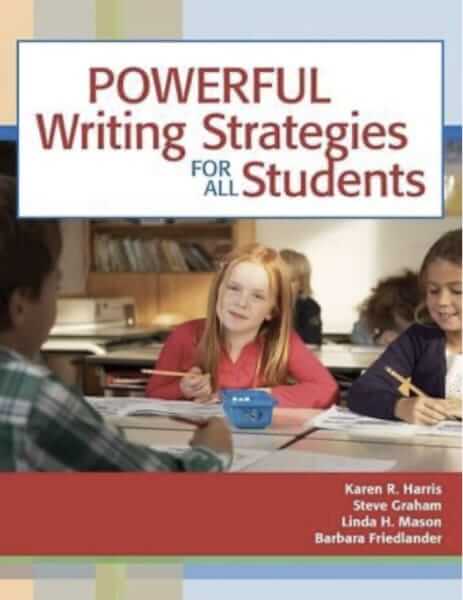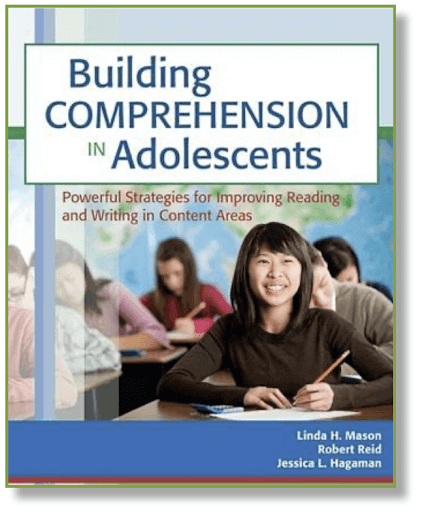Recommended Resources
These SRSD books and guides provide comprehensive information for improving students' writing skills through evidence-based strategies. They offer practical techniques for teaching writing processes and self-regulation tailored to diverse student needs, including those with learning disabilities. These resources are invaluable for educators seeking to enhance writing instruction and create independent, confident writers.

Redondo, Harris & Braaksma (2018)
This volume presents instructional programs focused on two aspects of writing: teaching writing as a skill and using writing as a learning tool across various subjects. It examines micro-design features (like learning activities, supporting materials, strategies, and techniques) and macro-design principles (such as instructional sequences and stages), all supported by research evidence. Beyond practical instruction, the book offers theoretical insights and empirical evidence to support the described programs. Several chapters include links to an open-access e-book that provides teacher and student materials for these instructional approaches.
“I am so excited about this book because it is truly a multiple country, with multiple lines of research contribution to the field of writing and learning, and there’s no other book like it before. It is dedicated to those of us who care so much about not only learning to write but writing to learn.” – Dr. Karen Harris

Harris, K. R., Graham, S., Mason, L. H., & Friedlander, B. (2008). Baltimore, MD: Brookes
“Powerful Writing Strategies for All Students,” by Karen R. Harris, Steve Graham, Linda H. Mason, and Barbara Friedlander, is an essential resource for educators seeking to enhance their students’ writing skills through evidence-based instructional strategies. The book provides a comprehensive guide to the Self-Regulated Strategy Development (SRSD) model, a proven approach that helps students improve their writing by teaching explicit strategies for planning, drafting, revising, and editing. Harris and Graham emphasize the importance of self-regulation, encouraging students to set goals, monitor their progress, and reflect on their writing process.
The book is structured to be user-friendly, offering step-by-step instructions, practical examples, and reproducible materials that teachers can use directly in their classrooms. Each chapter addresses different writing genres, such as persuasive, narrative, and informative writing, and includes strategies tailored to meet the diverse needs of all students, including those with learning disabilities and other challenges. The authors also discuss ways to motivate students and build their confidence as writers, which is crucial for developing lifelong writing skills. This book is a must-have for teachers dedicated to improving their students’ writing abilities through structured, effective, and research-backed strategies.

Mason, Reid and Hageman (2012)
Building Comprehension in Adolescents: Powerful Strategies for Improving Reading and Writing in Content Areas” by Linda H. Mason, Robert Reid, and Ian D. Byrd is an invaluable resource for educators aiming to enhance adolescents’ literacy skills. The book is grounded in evidence-based research and emphasizes the Self-Regulated Strategy Development (SRSD) model. This model offers practical techniques for summarizing, generating questions, and using graphic organizers, which is crucial for improving comprehension in content areas like science and social studies. The authors provide detailed lesson plans, reproducible materials, and examples, making it easy for teachers to implement these strategies in their classrooms. The focus on differentiation ensures that the strategies are tailored to meet the diverse needs of all students, including those with learning disabilities. The book also highlights the importance of motivation and self-efficacy, encouraging students to set goals, monitor progress, and reflect on their learning, fostering independence and confidence. This comprehensive guide supports teachers in embedding reading and writing strategies into their lessons to address the widespread comprehension problems among secondary school students and build a stronger foundation for academic success.

Xinghua Liu, Michael Hebert, & Rui A. Alves (2022)
Take a trip with Karen and Steve through the writing and reading research inspired by the creation of SRSD. “The Hitchhiker’s Guide to Writing Research” celebrates the extensive contributions of Steve Graham and Karen Harris to the science of writing research. This book compiles insights, stories, and studies from numerous researchers, many prominent in the SRSD community, showcasing the impact of Graham and Harris’ work on writing instruction and literacy development. It serves as a testament to his influential career and the legacy of his innovative approaches to education.

Reid, Lienemann & Hagaman (2013)
This book is a valuable resource for K-12 educators, offering a step-by-step guide to cognitive strategy instruction, a highly effective technique for helping struggling learners. The authors present well-validated strategies to enhance self-regulated learning, study skills, and writing, reading, and math performance. Detailed classroom examples show how to teach these strategies systematically and monitor student progress. The book includes over 20 reproducible worksheets, checklists, and tools, with access to downloadable materials in a convenient size. New additions to this edition include a chapter on lesson planning with sample lessons, handwriting and spelling, material on response to intervention and ADHD, expanded coverage of working memory, and additional strategies in content-area chapters.

Karen Harris and Steve Graham (2015)
Peer support and social relationships greatly impact all students’ development, motivation, and achievement, including struggling learners and those with disabilities. This practical book is a comprehensive guide for classroom teachers and special educators on implementing peer-assisted instructional strategies in grades K-12. Expert contributors present evidence-based methods to enhance students’ reading, writing, math, social competence, and executive functioning skills. The book includes sample lessons and over a dozen reproducible tools, with purchasers gaining access to a Web page for downloading and printing these materials. Key topics covered include fostering metacognitive awareness and academic success, differentiated instruction strategies, peer support in writing, collaborative strategic reading, improving word recognition and reading comprehension, peer-assisted learning in mathematics, cooperative learning benefits, peer-supported instruction for English learners, and the influence of preschool peers on social outcomes for children with special needs.

Graham, Harris, and Olinghouse (2007)
Executive Functioning in Education: From Theory to Practice,” edited by L. Meltzer, offers an in-depth understanding of executive function (EF) processes in children, including those with learning difficulties. This revised volume covers key EF skills like goal setting, organization, cognitive flexibility, working memory, and self-monitoring. Experts link EF to academic performance and provide practical assessment and instructional strategies. The chapter by Graham, Harris, and Olinghouse details how the Self-Regulated Strategy Development (SRSD) model helps students with EF difficulties improve writing by integrating planning, organizing, and goal setting into the writing process, showing notable improvements in their written work. This edition includes updates on research, early childhood education, embedding EF strategies in the curriculum, and expanded coverage on reading and self-regulation.

Steve Graham and Karen Harris (2005)
Writing Better: Teaching Writing Processes and Self-Regulation to Students with Learning Problems” by Steve Graham and Karen Harris is a comprehensive guide that delves into the Self-Regulated Strategy Development (SRSD) model, tailored specifically for students with learning challenges. This book equips educators with evidence-based strategies to improve writing skills across educational levels, from elementary to high school. It provides a structured approach to teaching writing processes, covering all phases, from brainstorming to revising. The book includes practical activities, mnemonic devices, and step-by-step action plans to enhance self-regulation and writing proficiency. Photocopiable worksheets and before-and-after examples demonstrate the effectiveness of these strategies in improving student outcomes. Educators will find this resource invaluable for its detailed guidance on adapting writing instruction to meet diverse student needs, ensuring that even struggling writers can develop a robust skillset and gain confidence in their writing abilities. The book emphasizes the importance of explicit, systematic instruction. It offers many tools to facilitate this, making it an essential addition to any teacher’s toolkit to support students with learning difficulties.

Karen Harris and Steve Graham (1996)
Making the Writing Process Work: Strategies for Composition and Self-Regulation” by Harris and Graham (1996) serves as a foundational text for implementing the Self-Regulated Strategy Development (SRSD) approach in educational settings. This book meticulously explores the SRSD model, providing educators with comprehensive guidance on its application, from preparation through implementation and evaluation. It delves deeply into developing critical self-regulation components within the writing process, offering cognitive strategies that demystify writing for students, helping them organize their thoughts and transform them into written products. The book emphasizes the dual focus on composition and self-regulation, adding significant value to language programs by enabling students to manage their writing tasks effectively. Detailed chapters break down each phase of SRSD instruction, making this an essential manual for teaching and enhancing compositional skills. Additionally, actual samples of student writing, presented before, during, and after SRSD instruction, vividly illustrate the substantial improvements in content and organization. The book also provides practical tips for teaching and integrating these strategies into the classroom, concluding with a chapter on evaluating the effectiveness of classroom writing programs. This comprehensive resource is indispensable for educators seeking to enhance their students’ writing skills through a structured, evidence-based approach.






